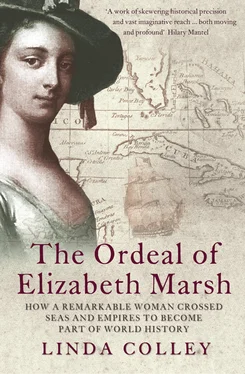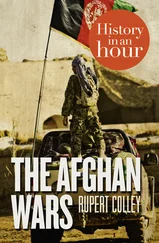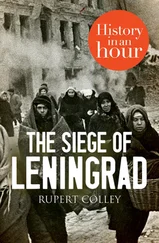To say that Elizabeth Marsh’s life and ordeal are recoverable, and that this in itself is eloquent about closer global connections in her time and in ours, is not the same as saying that the sources about her are abundant or easily yielding. To be sure, this was a woman who was addicted to writing. Even when (perhaps particularly when) she was confined to the lower decks of a store ship on the Indian Ocean, or in a Moroccan prison, she is known to have busied herself writing letters. Neither these, nor any other letters by her survive. Nor do any personal letters by her husband or parents survive, or any that might compensate for the lack of a portrait of her, by closely detailing her appearance. The colour of Elizabeth Marsh’s eyes and hair, like her height and the timbre of her voice, and the way she moved, remains, at least at present, beyond knowing. So does how she and others perceived exactly the colour of her skin.
This absence of some of the basic information which biographers can normally take for granted is partly why I have chosen to refer to Elizabeth Marsh often by her whole name, and sometimes only by her surname. Mainly for the sake of clarity, but also because of how she lived, I also refer to her only by her unmarried name. So in these pages she is always Elizabeth Marsh, never Elizabeth Crisp. The practice of always referring to female characters in biographies by their first names can have an infantilizing effect. It also suggests a degree of cosy familiarity that – as far as this woman is concerned – would be more than usually spurious. Certain aspects of her life and mind, as of her appearance, are unlikely ever to be properly known; though the impact she was able at intervals to make on others is abundantly clear.
What has survived to convey her quality and her actions over time are a striking set of journals, scrapbooks and sagas, compiled by her and by some members of her family. There are Elizabeth Marsh’s own Moroccan and Indian writings. Her younger brother, John Marsh, produced a memoir of his career. Her uncle, George Marsh, assembled a remarkable two-hundred-page book about himself and his relations and two commonplace books, and devoted journals to the more significant episodes in his life. Ostensibly concerned with personal and family happenings, achievements and disasters, these miscellaneous chronicles can be read also as allegories of much wider changes. Even some of the maps drawn by Elizabeth Marsh’s father contain more than their obvious levels of meaning. I have drawn repeatedly on these various family texts in order to decipher this half-hidden woman’s shifting ideas, emotions and ambitions.
Attempting this is essential because, although she undoubtedly viewed certain phases of her life as an ordeal, Marsh rarely presented herself straightforwardly as a victim. It was her own actions and plans, and not just the vulnerabilities attaching to her marginal status, the occupations and mishaps of her male relations, the chronology of her life, and the country and empire to which she was formally attached, that rendered her at intervals so mobile, and exposed her so ruthlessly to events. In particular, without attending closely to these private and family writings, it would be hard to make sense of five occasions – in 1756, in 1769, in 1770–71, in 1774–76, and again after 1777 – on which, to differing degrees, Elizabeth Marsh broke away from conventional ties of family and female duty, only to become still more vividly entangled in processes and politics spanning continents and oceans.
So this is a book that ranges between biography, family history, British and imperial history, and global histories in the plural. Because of the tendencies of our own times, historians have become increasingly concerned to attempt seeing the world as a whole. This has encouraged an understandable curiosity about very large-scale phenomena: the influence of shifting weather systems on world history, ecological change over time, patterns of forced and voluntary migration, the movement of capital, or commodities, or disease over continents, the transmission of ideas and print, the workings of vast overland and oceanic networks of trade, the impact of conflicting imperial systems, and so on. 10 These, and other such grand transcontinental forces, were and are massively important. Yet they have never just been simply and inhumanly there. They have impacted on people, who have understood them (or not), and adapted to them (or not), but who have invariably interpreted them in very many different ways. Writings on world and global history (to which I stand enormously indebted) sometimes seem as aggressively impersonal as globalization can itself.
In this book, by contrast, I am concerned to explore how the lives of a group of individuals, and especially the existence of one particular unsophisticated but not unperceptive woman, were informed and tormented by changes that were viewed at the time as transnational, and transcontinental, and even as pan-global, to an unprecedented degree. I seek to tack between the individual and world histories ‘in such a way as to bring them into simultaneous view’. 11 Writing some fifty years ago, the American sociologist C. Wright Mills suggested that at no other era had ‘so many men been so totally exposed at so fast a pace to such earthquakes of change’. The ‘earthquakes’ happening in the 1950s were due, he thought, to the collapse of old colonial empires and to the emergence of new, less blatant forms of imperialism, to the horrific implications of atomic warfare, to politicians’ surging capacity to deploy power over individual lives, to runaway modernization, and to inordinate pressure on marriage and the family. It was vital, Mills suggested, to try to understand the relationship between these ‘most impersonal and remote transformations’ and ‘the most intimate features of the human self’. Not least because those living through such earthquakes were often unable themselves to see this relationship clearly and make sense of it:
Seldom aware of the intricate connection between the patterns of their own lives and the course of world history, ordinary men [sic] do not usually know what the connection means for the kinds of men they are becoming and for the kinds of history-making in which they might take part. They do not possess the quality of mind essential to grasp the interplay of man and society, of biography and history, of self and world.
Instead, he suggested, men and women whose fate it was to ‘cope with the larger worlds with which they are so suddenly confronted’ often simply felt ‘possessed by a sense of trap’. 12
As far as Elizabeth Marsh is concerned, Mills’ characterization of the responses of those who live through ‘earthquakes’ of global change is both right and wrong. As will become clear, at times, and for good reason, she was indeed ‘possessed by a sense of trap’. But, like other members of her family, she tried to make sense of the changes transcending seas and continents that she and they were so markedly living through and acting out. The extent and quality of Elizabeth Marsh’s global earthquake in the mid-eighteenth century was substantially different from that perceived by Mills in the 1950s, though the flux of empire, enhanced state power, runaway military violence, modernization, and strains on the family and marriage were part of her experience too. Elizabeth Marsh’s earthquake was also very different from our own at the start of the twenty-first century. But the nature of her ordeal, her precocious and concentrated exposure to so many forces of transcontinental change, and her sense in the face of these ‘impersonal and remote transformations’ both of shock and wonder, entrapment and new opportunities, remain eloquent and recognizable. This is her story.
Читать дальше












